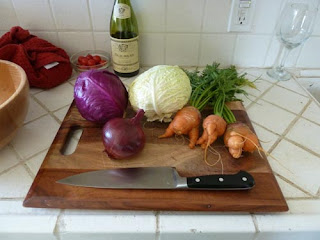Yes, it’s true. The first annual Pasadena Couscous Festival was last month. Equally true: I was there! Originally scheduled for one day, the festival was extended a second day to accommodate the response. Organized by
Ecole de Cuisine Pasadena at the
Chefs Center of California, the festival aimed to "raise awareness and admiration of the glorious flavors and techniques in North African cuisine.” That’s according to the press release.
 |
| Stock photo by Meghan Anderson-Colangelo |
The
Santa Anas came late this year so there were gray skies and a mild drizzle as Armand and I passed the entry gate to the grill stations set up in the parking lot. We oriented ourselves with batata chips, lamb-beef merguez, and live nomadic Saharan music. The couscous, vegetable tagine, and preserved lemon chicken tagine eaten later kept me full all day. With the balance on our food tickets, we finished the outing with Arabic coffee and a pastry sampling that included beignets I have craved ever since.
The chair was taken out from under as I listened to
Clifford A. Wright and
Charles Perry discuss food history. Did you know we use a totally bastardized method to cook couscous in this country? Couscous is not to be steeped lest it be heavy. Clifford Wright—a prolific academic and popular author on topics of Mediterranean and Arab cuisine, among others—presented Origins of Couscous and the First Pastas and stressed the grain product is at its best when steamed. This traditionally takes about three hours. Fortunately, the commonly used instant varieties can be steamed in a fraction of the time at only an hour or so. It becomes all the more flavorful when steamed two or three times, using broth or olive oil on the subsequent goes. Talk about dedication! During the Q and A, a savant-type in the audience provided the anecdote of a couscous box that said to add boiling water in English, French, and Spanish. Yet that same box instructed Arabic speakers to steam.
Turns out the savant was accomplished culinary expert Charles Perry, which explains his agility with the four languages. I did not hear much of what was said about couscous, but his lecture on Medieval North African and Andalusian Dishes introduced me to unexpected origins for fish and chips and Baja tacos, which I investigated further at home. Fish and chips, that iconic British dish, resulted from the Sephardic diaspora. Fried fish was among the cuisine Portuguese and Spanish Jews brought to England, where it became
custom in the 1800s to serve with fries. Quintessentially British, the meal was born with one foot on the Iberian Peninsula and the other in Belgium or France (the origin of fries is disputed).
Likewise, named for the Mexican peninsula of their origin, Baja tacos resulted from a meeting of cultures. Japanese immigrants who were part of Baja’s fishing economy brought new customs, and introduced their own twist to the local food—fish tempura. Using the fried fish in place of traditional meats gave way to the tacos de pescado frito everlastingly loved by so many on the Mexico-California coast.
All in all: the eating was good and the information was interesting. I look forward to next year’s Couscous Festival.





























